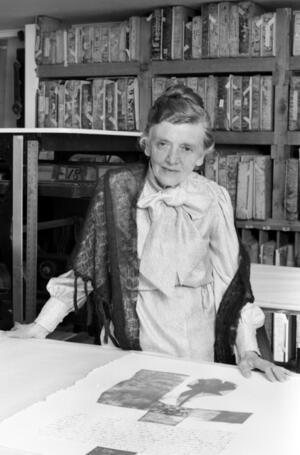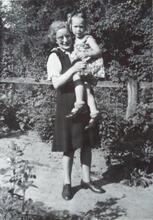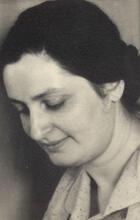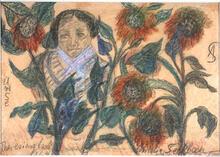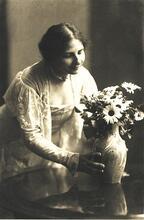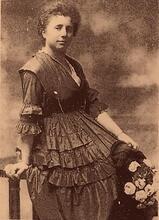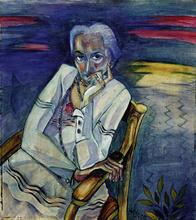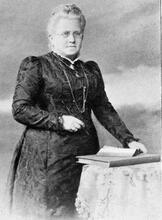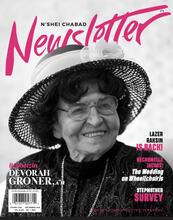Tatyana Grosman
Tatyana Grosman helped make American printmaking a respected medium through Universal Limited Art Editions (ULAE), the studio and publishing house she founded in 1957. Grosman’s family fled the Russian Revolution in 1918, staying briefly in Japan before settling in Dresden, where Grosman studied at the Academy of Applied Arts. In 1931 she married Maurice Grosman, a struggling painter, and the couple fled Germany and settled in New York in 1943. Grosman bought a lithograph press, encouraged artists and poets to use her Long Island home as a retreat, and published their ensuing work. The ULAE became known for its creative fusion of words and pictures. Much of the press’s work was acquired by the Metropolitan Museum of Art and the Art Institute of Chicago.
Tatyana Grosman nurtured an entire generation of printmakers and raised printmaking in the United States to the status of a major fine art. Universal Limited Art Editions, which she founded in 1957 at her home in Long Island, New York, published prints by many of the major American artists of her generation and launched collaborative endeavors between artists and writers. Her home became a uniquely fertile environment providing both the tools and the critical encouragement for virtually every type of printmaking.
Early Life and Family
She was born Tatyana Auguschewitsch in Ekaterinburg (now Sverdlovsk) in Siberia on June 30, 1904 (June 17 according to the Russian calendar), to Jewish parents who had officially converted to Christianity because of the implacable antisemitism of Russian laws. The government had sent her father, Semion Michailovitch Auguschewitsch, as a typographer to start a newspaper in Siberia at age twenty-one. Such was his success that the family was able to live in luxury and elegance in the midst of their rough frontier town. While her father never observed any Christian rituals, her mother, Anna de Chochor, who came from a family of Russian Jews that had emigrated to Bavaria in the nineteenth century, made Tatyana wear a cross and go to church. She grew up introverted and shy, a great reader of Russian classics, who studied art and loved to act as well.
In 1918, as the Russian Revolution gathered force, the family left for Japan. There, Tatyana attended the Sacre Coeur Convent in Tokyo, and was captivated by the country’s serene, meditative esthetic. The next year they traveled via Venice to Dresden, where her mother’s sister lived. Tatyana graduated from the Dalcrose boarding school in nearby Hellerau, and went on to study drawing and fashion design at Dresden’s Academy of Applied Arts. Drawing upon Japanese inspiration, she created an Oriental costume that won the school’s highest design prize in 1928.
Marriage to Maurice Grosman and Immigraton
The following year she met and fell in love with Maurice Grosman, a struggling artist who at twenty-nine was already divorced with a son. A Jew from Poland with its Yiddish traditions, he was flamboyant, bohemian, poor, and contemptuous of worldly success, a combination irresistible to Tatyana and anathema to her mother. As Tatyana once said, she had never been in a synagogue but she had always wanted to be Jewish. Her mother banished her, but she willingly left her luxuries behind to live with Maurice in an attic. They were married on June 27, 1931.
In 1932, she insisted they leave an increasingly dangerous Germany for Paris. In Montmartre, Maurice painted and they shared in an artists’ community and café life with Jacques Lipchitz, Chaim Soutine, and Ossip Zadkine. It was in France that their only child, Larissa, was born on January 31, 1933, only to die sixteen months later. Then in 1938, Tatyana’s beloved father, under the strains of a difficult marriage and the hell that Germany was becoming, committed suicide.
In November 1940, two days before the Nazis took Paris, the Grosmans fled. They survived three years of danger and flight, crossing the Pyrenees on foot, and finally reaching friends in Barcelona. With the help of the Hebrew Immigrant Aid Society, they arrived in New York on May 23, 1943, and settled in a one-room, fifth-floor walk-up on 8th Street.
For the next twelve years, Tatyana Grosman played the role of artist’s wife as Maurice Grosman eked out a living for them with his painting and teaching. Then, in 1955, he had a heart attack. They left the now insurmountable walk-up for a six-room gardener’s cottage they owned in West Islip, Long Island, and Tatyana Grosman assumed new responsibilities as breadwinner.
Universal Limited Art Editions (ULAE)
At first, she promoted Maurice’s silk-screen reproductions of famous and contemporary paintings. But museum curators were interested only in original works; a change of direction was needed. The Grosmans found some lithographic stones and bought an old press for fifteen dollars. Tatyana Grosman conceived a vision: She would bring together American artists and poets to produce works equal to the classic French artists’ books, and then act as their publisher. With a growing sense of mission and her lifelong passion for art, literature, and the printed page, she began what was to become her lifework: to initiate collaborations between artists and writers, to foster rising artists’ use of the tools of printmaking, and then to bring their works to collectors, galleries, and museums. Universal Limited Art Editions (ULAE) was formed in 1957 to pursue these goals.
The first project was a series of prints entitled Stones, by two of the Grosmans’ friends, painter Larry Rivers and poet Frank O’Hara. A collaboration between Robert Rauschenberg and the French novelist and film writer Alain Robbe-Grillet followed, along with many others. Grosman would urge artists to come to West Islip to work, use printmaking equipment at any hour of the day or night, and enjoy lavish food and lively conversation. She created a nurturing artistic environment in which, despite lack of money, she catered unstintingly to her artists’ whims and creature comforts, and provided the finest materials and the most meticulous printers, as well as an unfailing source of personal attention and provocative comment on their work. Painter Robert Motherwell said, “Her integrity, tenacity, endless patience, extravagance with time and materials are as rare as is the ambiance of her workshops, where it is simply assumed that the world of the spirit exists as concretely as lemon yellow or women’s hair, but transcends everyday life.” As the poet Edwin Schlossberg put it, she “seemed to reach and recognize exactly the you that you always wanted someone to know … to give it full range to be what it was and could be … Tatyana was in love with the people with whom she worked.”
Over the quarter century from the founding of ULAE until her death, Grosman expanded the studio’s range of media from silk-screen and lithography to etching and aquatint, woodcuts, offset lithography, and photolithography. Among the many rising artists brought to ULAE through Maurice Grosman’s excellent instincts and the recommendations of other artists were Helen Frankenthaler, Grace Hartigan, Jasper Johns, Barnett Newman, Robert Motherwell, Jim Dine, Jacques Lipschitz, Max Weber, Sam Francis, Lee Bontecue, Marisol, Buckminster Fuller, James Rosenquist, Claes Oldenburg, Cy Twombly and Saul Steinberg. Gradually, ULAE prints came to be regarded as modern classics. They were exhibited around the world, and many were acquired by the New York Metropolitan Museum of Art and the Art Institute of Chicago. An offshoot enterprise, Telamon Editions, founded in 1969, used offset printing to produce moderate-cost, high-quality posters and books to subsidize and publicize the work of ULAE.
Legacy
Maurice Grosman died in 1976. After months of depression, Tatyana Grosman was persuaded to resume her work, but was frequently ill. During her last years, she was honored with a doctor of fine arts degree from Smith College in 1973, a doctor of letters from Dowling College in 1977, and a Brandeis University award for outstanding achievement in the arts in 1981. She died on July 24, 1982.
Tatyana Grosman was a pioneer and a risk-taker. Born of a Jewish family that passed as Christian, and raised in Russia and Germany where to be a Jew meant hardship and danger, she chose to embrace Jewishness in her adult life. Brought up in bourgeois luxury and expected to marry well, she chose the life of a struggling artist. In New York, when her husband became ill, she turned hardship into creative opportunity. Here, strands from her early travels and passions flowed together: a love of the printer’s craft and the printed page from her childhood as a typographer’s daughter in Siberia, an elegant sense of design influenced by her stay in Japan, a feeling for the European traditions of printmaking and the artist’s book, and perhaps a Parisian sense of woman as muse, presiding over her salon. With her determination and charisma, she established an extraordinary creative greenhouse in which artists could range freely and flourish, and she tirelessly brought their produce to market. Under Tatyana Grosman’s energetic cultivation, contemporary American printmaking came into its own as a major fine art form.
Mitgang, Herbert. “Tatyana Grosman: ‘The Inner Light of 5 Skidmore Place.’” Art News. Special prints issue (March 1974): 28–32.
Rivers, Larry. “Tatyana Grosman.” Art News 81, no. 8 (October 1982): 101–102.
Russell, John. “Tatyana Grosman, Print Publisher, 78.” NYTimes, July 26, 1982.
Sparks, Esther. Universal Limited Art Editions: A History and Catalogue: The First Twenty-Five Years (1989).
Tomkins, Calvin. “The Art World: Tatyana Grosman.” New Yorker (August 9, 1982): 83.

